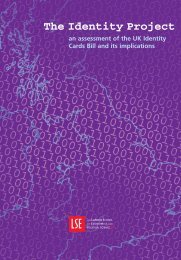Money Laundering: Review of the Reporting ... - Dematerialised ID
Money Laundering: Review of the Reporting ... - Dematerialised ID
Money Laundering: Review of the Reporting ... - Dematerialised ID
Create successful ePaper yourself
Turn your PDF publications into a flip-book with our unique Google optimized e-Paper software.
kpmg<br />
<strong>Review</strong> <strong>of</strong> <strong>the</strong> regime for handling Suspicious Activity Reports<br />
Report <strong>of</strong> recommendations<br />
KPMG LLP<br />
• LEAs would also provide specific requests on an ongoing basis for particular types <strong>of</strong><br />
information or relating to particular investigations, which <strong>the</strong> LU would <strong>the</strong>n pass on<br />
to <strong>the</strong> wider pool <strong>of</strong> disclosing entities and <strong>the</strong> relevant regulators and trade bodies.<br />
• LEAs should also record <strong>the</strong>ir interest in certain subjects through conducting specific<br />
searches <strong>of</strong> <strong>the</strong> Elmer database. This will allow future SARs on <strong>the</strong>se subjects to be<br />
automatically allocated to <strong>the</strong> LEA that previously registered an interest.<br />
7.5 Sectoral differences in compliance and enforcement<br />
7.5.1 There is a difference in <strong>the</strong> oversight and regulation <strong>of</strong> different industries which are<br />
potentially vulnerable to abuse and money laundering. The financial services industry is<br />
regulated by <strong>the</strong> FSA, which was given specific responsibilities in relation to financial<br />
crime under <strong>the</strong> FSMA in December 2001. It has, as a result, taken a more active and<br />
interventionist role in relation to regulated entities’ AML controls. The nature <strong>of</strong><br />
regulation for solicitors and accountants is less focused on systems and controls within<br />
<strong>the</strong> relevant firms or at sole practitioners. O<strong>the</strong>r industries, whe<strong>the</strong>r estate agents, <strong>the</strong> art<br />
and jewellery markets or companies specifically focused on company formation, are not<br />
currently subject to such regulation although High Value Dealers will be regulated by<br />
HMC&E once <strong>the</strong> 2003 MLRs come into effect.<br />
7.5.2 Although <strong>the</strong> banks will continue to be fundamental in relation to AML activity, given<br />
that ultimately <strong>the</strong> money related to criminal activity will need to pass through bank<br />
accounts, money launderers are likely to focus on <strong>the</strong> weakest points in <strong>the</strong> financial<br />
system. This will, in part, relate to less active regulation in certain sectors and <strong>the</strong><br />
potential for less focus on and compliance with <strong>the</strong> legal requirements. It will also follow<br />
those products that are easier to use to launder money than o<strong>the</strong>rs, where <strong>the</strong>re is a less<br />
obvious and accessible audit trail for a financial investigator. Cash remains <strong>the</strong> most<br />
anonymous asset type, but o<strong>the</strong>rs include jewellery and high value consumer goods.<br />
Recommendation 14<br />
Feedback on under-reporting sectors and individual firms<br />
7.5.3 The <strong>ID</strong>U should carry out sectoral analysis <strong>of</strong> all <strong>the</strong> types <strong>of</strong> providers <strong>of</strong> SARs,<br />
including <strong>the</strong> identification <strong>of</strong> any new sectors which potentially appear to be used for<br />
money laundering activities. This information should <strong>the</strong>n be discussed with <strong>the</strong> relevant<br />
regulators (if <strong>the</strong>re are any for <strong>the</strong> particular sector in question) or trade body/association.<br />
The <strong>ID</strong>U should liaise with overseas FIUs, LEAs and <strong>the</strong> Egmont group to identify trends<br />
that may affect or benefit <strong>the</strong> UK system.<br />
Role <strong>of</strong> <strong>the</strong> Task Force<br />
7.5.4 Both <strong>the</strong> analysis and <strong>the</strong> conclusions <strong>of</strong> <strong>the</strong>se discussions should be provided to <strong>the</strong> Task<br />
Force so it can periodically assess <strong>the</strong> nature <strong>of</strong> <strong>the</strong> regulatory and o<strong>the</strong>r measures in place<br />
for encouraging compliance with <strong>the</strong> SAR regime. In particular, <strong>the</strong> Task Force should<br />
review <strong>the</strong> effectiveness <strong>of</strong> <strong>the</strong> widening <strong>of</strong> <strong>the</strong> scope <strong>of</strong> <strong>the</strong> MLRs in June 2003, ins<strong>of</strong>ar<br />
as <strong>the</strong>y relate to SARs. It should mobilise individual regulators and trade associations to<br />
adapt <strong>the</strong> nature and scope <strong>of</strong> <strong>the</strong>ir interventions where issues <strong>of</strong> uneven compliance arise.<br />
jo/fh/519 70









